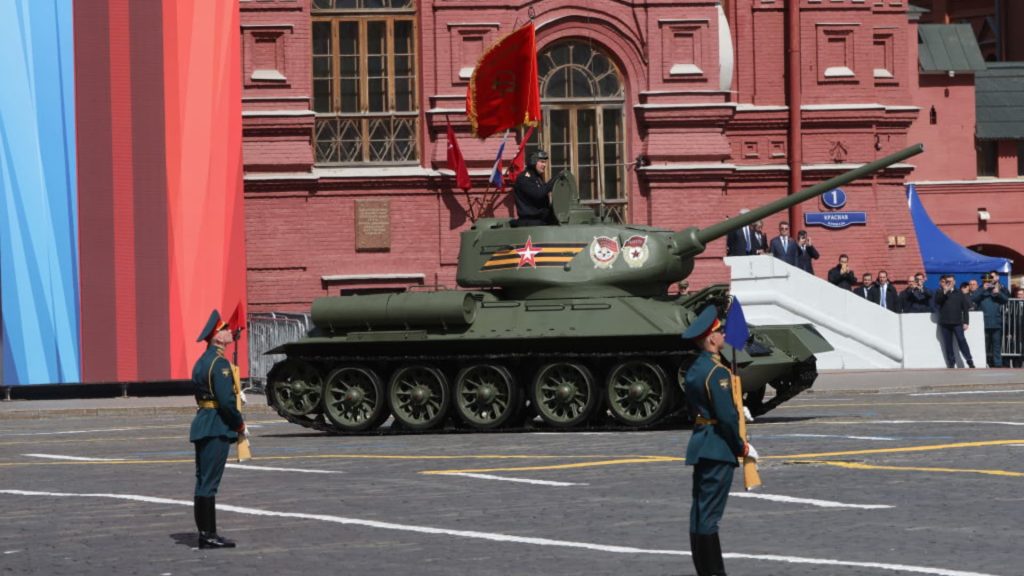Russia’s scaled-down Victory Day military parade showed not only Moscow’s insecurities over possible Ukrainian attacks but also highlighted the country’s depleted military resources due to the conflict, political analysts said.
May 9 is a public holiday in Russia when it commemorates the Soviet Union’s victory over Nazi Germany in World War II. It is arguably the most important day in Russia’s public calendar and history, forming a central part of the country’s modern national identity.
This year’s military parade through Red Square in Moscow and celebrations around the country were noticeably smaller than in previous years or entirely canceled, with six regions (including annexed Crimea) and at least 20 cities halting their commemorations.
In Moscow on Tuesday, the military parade was more downbeat, with no fly-past or “Immortal Regiment” processions — which are usually largescale public events to commemorate those killed in World War II. There were also far fewer troops and military hardware on show than in previous years.
The fact that only one Stalin-era tank was on display in the military parade through Red Square was particularly eye-catching, analysts noted.
“It would be hard to image a more fitting symbol of Russia’s declining military fortunes than the sight of a solitary Stalin-era tank trundling across Red Square during the country’s traditional Victory Day celebrations on May 9,” Peter Dickinson, the editor of the UkraineAlert journal at the Atlantic Council, commented Tuesday.
“For the past two decades, Vladimir Putin has used Victory Day to showcase modern Russia’s resurgence as a military superpower, with dozens of the very latest tanks typically taking part in each annual parade. This year, however, the only tank on display was a T-34 model dating back to World War II.”
Dickinson noted that, “inevitably, the embarrassing absence of tanks at this year’s Victory Day parade has been widely interpreted as further evidence of Russia’s catastrophic losses in Ukraine,” a point echoed by the U.K.’s Ministry of Defence.
Commenting Wednesday, the ministry noted that “the make-up of Russia’s annual Victory Day Parade in Red Square highlighted the materiel and strategic communications challenges” the Russian military is facing 15 months into the war in Ukraine.
“Over 8,000 personnel reportedly took part in the parade, but the majority were auxiliary, paramilitary forces, and cadets from military training establishments,” the ministry noted in its latest intelligence update on Twitter, adding that “the only personnel from deployable formations of regular forces were contingents of Railway Troops and military police.”
A spokesperson for the Russian defense ministry wasn’t immediately available for comment when contacted by CNBC.
Kremlin concerns
Security concerns were the ostensible reason for scaled-back Victory Day events in Russia, with an alleged drone attack on the Kremlin last week (that Russia blamed on Ukraine and the U.S. which they both denied) acting as a precursor to — and justification for — a lower-profile event.
But military analysts noted that the Kremlin was also likely keen to avoid any opportunity for public criticism of its invasion, which it still maintains is a “special military operation” — the only mention of war on Tuesday being Russian President Vladimir Putin’s claim to crowds in Red Square that “a real war is being waged against our Motherland” despite the fact that Russia invaded its neighbor Ukraine.
Noting the one solitary “vintage” T-34 tank on display, the U.K.’s defense ministry said that despite heavy losses in Ukraine, Russia could have fielded more armored vehicles but that “the authorities likely refrained from doing so because they want to avoid domestic criticism about prioritising parades over combat operations.”
Atlantic Council’s Dickinson noted too that the banning of this year’s “Immortal Regiment” marches, usually massively popular affairs when the Russian public get a chance to commemorate their loved ones lost in WWII, “was an even bigger blow” and that the Kremlin was likely concerned that family members of Russian soldiers killed in Ukraine could seek to participate.
“With Russian officials still in denial over the disastrous consequences of the Ukraine invasion, the last thing the Kremlin wanted was for thousands of grieving relatives to gather in public and draw attention to the scale of the tragedy,” Dickinson noted.
Ukraine’s schadenfreude
Ukraine was obviously quick to remark on the scaled-down Victory Day parade.
The Ukrainian Defense Ministry’s official Twitter account quipped that “modern Russian military equipment can be found much more easily at Ukrainian military trophies exhibitions than at the Victory Parade in Moscow” while Ukrainian MP Oleksiy Goncharenko said on Twitter that the whole of Ukraine was laughing at Russia’s one tank.
Ukraine continues to distance itself from Russia’s sphere of influence and orbit and on Tuesday, President Volodymyr Zelenskyy submitted a draft law to the Ukrainian Parliament proposing that May 8 be known as “the Day of Remembrance and Victory over Nazism in the Second World War” rather than May 9, as in Russia and other former Soviet republics.
He said that from now on, May 9 would in Ukraine be known as “Europe Day,” with Zelenskyy noting that “we will commemorate our historic unity — the unity of all Europeans who destroyed Nazism and will defeat Ruscism,” a word Ukraine uses to describe “Russian fascism.”
Read the full article here
